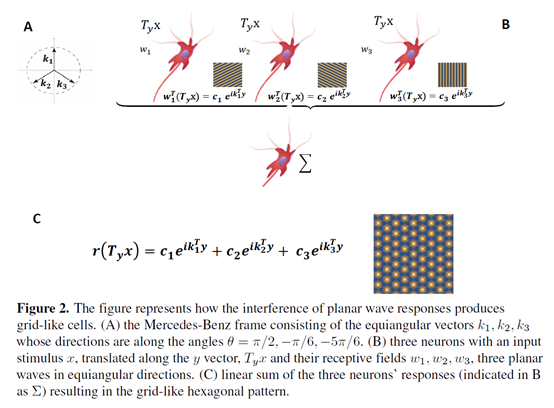
How grid cells could possibly organize?
Anselmi, Fabio, Benedetta Franceschiello, Micah M. Murray, and Lorenzo Rosasco. “A computational model for grid maps in neural populations.” arXiv preprint arXiv:1902.06553 (2019).
The following content is extracted from Anselmi 2019.
Anselmi, Fabio, Benedetta Franceschiello, Micah M. Murray, and Lorenzo Rosasco. “A computational model for grid maps in neural populations.” arXiv preprint arXiv:1902.06553 (2019).
Since their discovery in 2005 grid cells have played a key-role in understanding how different species’ brains dynamically represent an animal’s position in space. Despite more then a decade of interest from a large number of investigators, a universally accepted model of how grid cells receptive fields emerge is still lacking.
In this study Anselmi et al. 2019 provides a new and simple theoretical and computational framework to explain how grid cells could possibly organize. We propose a novel formulation of the encoding problem through the modern Frame Theory language, providing new insights about the optimality of hexagonal grid receptive fields and overcoming some crucial limitations of the current attractor and oscillatory models. Moreover, they demonstrate that this same encoding strategy can generalize from spatial to more abstract information.

Fig from Anselmi et al. 2019.
For further info, please read the paper Anselmi et al. 2019
Anselmi, Fabio, Benedetta Franceschiello, Micah M. Murray, and Lorenzo Rosasco. “A computational model for grid maps in neural populations.” arXiv preprint arXiv:1902.06553 (2019).
About
Brain Inspired Navigation Blog
New discovery worth spreading on brain-inspired navigation in neurorobotics and neuroscience
Recent Posts
- How human, animals, robots encode and recall place?
- How the brain constructs time and space and how these are related to episodic memory?
- How environmental novelty modulate rapid cortical plasticity during navigation?
- How the Hippocampal Cognitive Map Supports Flexible Navigation?
- How the geometric structure and underlying circuit organization of hippocampal population dynamics facilitate both memory discrimination and generalization, enabling efficient and flexible learning?
Tags
Categories
- 3D Movement
- 3D Navigation
- 3D Path Integration
- 3D Perception
- 3D SLAM
- 3D Spatial Representation
- AI Navigation
- Bio-Inspired Robotics
- Brain Inspired Localization
- Brain-Inspired Navigation
- Cognitive Map
- Cognitive Navigation
- Episodic Memory
- Excerpt Notes
- Flying Vehicle Navigation
- Goal Representation
- Insect Navigation
- Learning to Navigate
- Memory
- Neural Basis of Navigation
- Path Integration
- Path Planning
- Project
- Research Tips
- Robotic Vision
- Self-Flying Vehicles
- Semantic Memory
- Spatial Cognition
- Spatial Cognitive Computing
- Spatial Coordinate System
- Spatial Learning
- Spatial Memory
- Spatial Resoning
- Time
- Unclassified
- Visual Cortex
- Visual Cue Cells
Links
- Laboratory of Nachum Ulanovsky
- Jeffery Lab
- BatLab
- The NeuroBat Lab
- Taube Lab
- Laurens Group
- Romani Lab
- Moser Group
- O’Keefe Group
- DoellerLab
- MilfordRobotics Group
- The Space and Memory group
- Angelaki Lab
- Spatial Cognition Lab
- McNaughton Lab
- Conradt Group
- The Fiete Lab
- The Cacucci Lab
- The Burak Lab
- Knierim Lab
- Clark Spatial Navigation & Memory Lab
- Computational Memory Lab
- The Dombeck Lab
- Zugaro Lab
- Insect Robotics Group
- The Nagel Lab
- Basu Lab
- Spatial Perception and Memory lab
- The Neuroecology lab
- The Nagel Lab
- Neural Modeling and Interface Lab
- Memory and Navigation Circuits Group
- Neural Circuits and Memory Lab
- The lab of Arseny Finkelstein
- The Epstein Lab
- The Theoretical Neuroscience Lab
- Gu Lab (Spatial Navigation and Memory)
- Fisher Lab (Neural Circuits for Navigation)
- The Alexander Lab (Spatial Cognition and Memory)
- Harvey Lab (Neural Circuits for Navigation)
- Buzsáki Lab
- Brain Computation & Behavior Lab
- ……